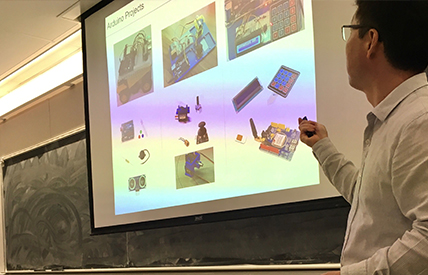San Diego Math Circle Widens at UC San Diego
Dec. 20, 2019 | By Melissa Miller
 David Brown taught a lesson on vectors to upper middle-school students on a recent Saturday. “Being a physicist I like to be visual,” he says, supplementing his slides with props to keep his young audience attentive. Photo by Melissa Miller
David Brown taught a lesson on vectors to upper middle-school students on a recent Saturday. “Being a physicist I like to be visual,” he says, supplementing his slides with props to keep his young audience attentive. Photo by Melissa Miller
Enthusiastic math students in junior high and high school come together from all over the county at UC San Diego to learn topics that aren’t taught in their schools. This “San Diego Math Circle” (SDMC) results in a community of students and instructors who enjoy being challenged.
David Meyer, a math professor at UC San Diego, serves as liaison between the Department of Mathematics and San Diego Math Circle. He is also the parent of a SDMC student, and he recently taught a session called “Pentagramma Mirificum” to high-school students.
“It’s an opportunity for me to explain fun parts of math that I could teach to undergraduates, but which often don’t fit neatly into any of our courses,” said Meyer. “Other instructors from UCSD take this same opportunity to explain topics they enjoy to this group of students, who also enjoy them.”
SDMC connects instructors—many from UC San Diego—with interested students in grades 5 through 12. David Brown, director of SDMC, said he recruits instructors by matching their favorite topics to students of a suitable age or ability group. A former research scientist at UC San Diego’s Institute for Nonlinear Science, Brown teaches sessions such as “Euclidean Vectors” and “Irrationality.” Though he’s spent a lot of time around the subject of math, he admits there are topics being taught to the upper division high-school students that go over his head. According to him, these exceptional students require a different way of learning.
“We intentionally don’t teach in a linear way because then it feels like school,” Brown said.
For starters, SDMC classes take place on the weekends. Saturday mornings may begin with a traditional lecture but often include group discussion and problem-solving. Saturday afternoons are dedicated to computer science topics. Sunday afternoons explore mixed STEM topics, including hands-on workshops dealing with electricity and circuits or building robotic devices.
“A lot of K-12 students learn to think that math is about being able to find the right answers to questions, through applying the right algorithm at the right time,” said Kris Siy, an SDMC instructor who recently taught the classes “The Pigeonhole Principle” and “Ramsey Theory.”
 John Lee teaches STEM students through progressively harder assignments using Arduino robotic controllers. Hands-on projects include equipping a Tonka truck with a backup sensor (beginner), a two-jointed robot controlled by a joystick (intermediate) and assembling a functioning cell phone (advanced). Photo by Melissa Miller
John Lee teaches STEM students through progressively harder assignments using Arduino robotic controllers. Hands-on projects include equipping a Tonka truck with a backup sensor (beginner), a two-jointed robot controlled by a joystick (intermediate) and assembling a functioning cell phone (advanced). Photo by Melissa Miller
According to Siy, mathematics encompasses many other under-emphasized parts in the problem-solving process that students can benefit from. “For example, I emphasize that anyone making meaning out of interesting situations, asking questions, searching for answers to these questions through pattern-finding, or creating and justifying conjectures is doing mathematics, even if there's no ‘final answer’ at the end of all of it,” he said.
It takes dedication and enthusiasm from all participants to keep Math Circle running. Brown is on campus every weekend and relies on parents for classroom support; a few volunteers each week shepherd students to lecture halls and make sure the instructors have what they need. Attendance isn’t mandatory, but many participants choose to spend their weekends supporting the Math Circle community.
“For some, it is their only experience being with a group of other students at their same level,” Meyer says. “This seems to be especially important for girls, or at least it is for my daughter—making friends with several other girls at SDMC has helped encourage her to keep pushing beyond the math that is taught at her school.”
UC San Diego physics graduate student Jacob Saret is teaching eight sessions this year. He sees Math Circle as an enrichment, not necessarily advancement, of the students’ math education. At 19 years old, Saret is only a few years older than some of his students. He attended Math Circle classes in Northern California as a kid and was sitting in on college lectures by the age of 10. As an experimental plasma physicist, Saret knows that many disciplines require understanding math as a way of thinking.
“Math is the language of science,” he says, quoting Galileo.
Nathan Green, a math professor at UC San Diego, sees teaching at Math Circle as a way to give back to the math community.
“I want to show the kids that math can be stimulating and enjoyable, that it's not just the drudgery of math homework. I really enjoyed doing this kind of thing when I was a kid and it got me interested in math,” he said.
Math Circle students and instructors alike benefit from the environment of cooperative learning. Students who aren’t often challenged by their schoolwork relish the struggle to comprehend advanced topics, while the instructors thrive in front of an audience interested in their favorite topics. UC San Diego opening its doors to the exceptional students of San Diego Math Circle also benefits.
“Some of the SDMC students end up as students at UCSD, either doing summer research or taking classes while still in high school, or eventually enrolling as regular undergraduates,” Meyer says. “They are some of our best math students.”
To learn more about or to support San Diego Math Circle, check out its website.

